Los elementos de final de serie enumerativa del tipo y todo eso, o cosas así, y tal, etcétera en el discurso oral en español. Perspectiva textual
Résumé
O estudo das séries enumerativas do discurso oral em espanhol tem-nos permitido observar como uma porcentagem das referidas séries finaliza com um marcador de fechamento do tipo y todo eso, o cosas así, y tal, etcétera. Este artigo analisa a caracterização, a tipologia e as funções destes marcadores, mas somente da perspectiva textual (em artigos posteriores o faremos desde as perspectivas interativa e sociolingüística).Références
AIJMER, K. 1985. “What happens at the end of our utterances? The
use of utterance-final tags introduced by ‘and’ and ‘or’”, Papers from the
th Scandinavian Conference of Linguistics, Copenhague, Institut for
Philologie, Kopenhaven University, p. 366-389.
BALL, C.; ARIEL, M. 1978. “Or something, etc.”, Penn Review of
Linguistics, 3, p. 35-45.
BEINHAUER, W. 1978. El español coloquial. 3ª ed. Madrid: Gredos.
BROTHERTON, P. 1976. Aspects of the relationship between speech
production. Hesitation behaviour and social class. Tesis Doctoral.
University of Melbourne.
CHANNELL, J. 1994. Vague language. Oxford: Oxford University Press.
DINES, E. 1980. “Variation in discourse-and stuff like that”, Language
in Society, 1, p. 13-31.
CRYSTAL, D.; DAVY, D. 1975. Advanced conversational English. Londres: Longman.
DUBOIS, S. 1992. ”Extensión particles, etc.”, Language Variation and
Change, 4, p. 179-203.
EDIGER, A. 1995. An analysis of set-marking tags in the English language, Dissertation University of California, Los Ángeles.
JEFFERSON, G. 1990. “List construction as a tast and interactional
resource”, en G. Psathas (ed.). Interaction Competence. Washington (DC): University Press of America, p. 63-92.
LERNER, G.H. 1994. “Responsive list construction. A conversational
resource for accomplishing multifaceted social action”, Journal of
language and social psychology, 13, p. 20-33.
MEYERHOFF, M. 1992. “’A sort of something’ hedgins strategies on nouns”, Working Paper Language, Gender and Sexism, 2, p. 59-73.
NORRBY, C.; WINTER, J. 2001. “’Affiliation in adolescents’ use of
discourse extenders”, Proceedings of the 2001 Conference of the
Australian Linguistic Society http://linguistics.anu.edu.au/ALS2001/papers/ winter_norrby.pdf, 11 pp.
OVERSTREET, M. 1999. Whales, candlelight, and stuff like that. General extenders in English discourse. Oxford: Oxford University Press.
SANTOS RÍO, L.. 2003. Diccionario de partículas, Salamanca, LusoEspañola de Ediciones.
STUBBE, M.; HOLMES, J. 1995. “You know, eh and other
‘exasperating expressions’: an analysis of social and stylistic variation in
the use of pragmatic devices in a sample of New Zealand English”,
Language and Communication, 15, 1, p. 63-88.
WARD, G.; BIRNER, B. 1993. “The semantics and pragmatics of ‘and
everything’”, Journal of Pragmatics, 19, p. 205-214.
Téléchargements
Publiée
Comment citer
Numéro
Rubrique
Licence
© Luis Cortés Rodrigues 2006

Ce travail est disponible sous la licence Creative Commons Attribution 4.0 International .
Autores que publicam na Revista Investigações concordam com os seguintes termos:
Autores mantêm os direitos autorais e concedem à revista o direito de primeira publicação, com o trabalho simultaneamente licenciado sob a licença Creative Commons Atribuição 4.0 Internacional (CC BY 4.0) que permite o compartilhamento do trabalho com reconhecimento da autoria e publicação inicial nesta revista.
Autores têm autorização para assumir contratos adicionais separadamente, para distribuição não-exclusiva da versão do trabalho publicada nesta revista (exemplo: depositar em repositório institucional ou publicar como capítulo de livro), com reconhecimento de autoria e publicação inicial nesta revista.
Qualquer usuário tem direito de:
Compartilhar — copiar e redistribuir o material em qualquer suporte ou formato para qualquer fim, mesmo que comercial.
Adaptar — remixar, transformar e criar a partir do material para qualquer fim, mesmo que comercial.
O licenciante não pode revogar estes direitos desde que você respeite os termos da licença.
De acordo com os termos seguintes:
Atribuição — Você deve dar o crédito apropriado, prover um link para a licença e indicar se mudanças foram feitas. Você deve fazê-lo em qualquer circunstância razoável, mas de nenhuma maneira que sugira que o licenciante apoia você ou o seu uso.
Sem restrições adicionais — Você não pode aplicar termos jurídicos ou medidas de caráter tecnológico que restrinjam legalmente outros de fazerem algo que a licença permita.

